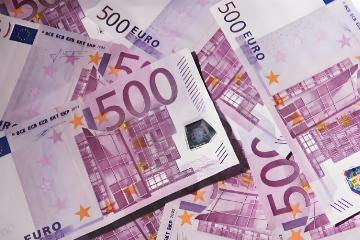Europe Lowers Interest Rate Expectations
Advertisements
The European economy has begun to show signs of recovery as we enter 2025, but the road ahead remains fraught with challengesAmong these are persistent soft demand and rising inflation, which continue to pose significant hurdles for economic growth in the EurozoneAs various economic indicators are made public, analysts keep a close eye on private sector activity across the major countries within the Eurozone, particularly Germany and France, to gauge the overall health of the economy.
In Germany, January marked a stabilization in private sector business activity after a six-month contractionThis improvement, however, was primarily driven by growth in the service industry, which managed to offset a continual decline in manufacturing outputAccording to the Purchasing Managers' Index (PMI) data released by S&P Global and Hamburger Sparkasse on January 24, business activity in the Eurozone, as well as in Germany and France, came in with initial estimates that were closely monitored by market participants.
Nevertheless, the optimism surrounding business activity is tempered by ongoing concerns about demand
Advertisements
The Eurozone's PMI for services registered a slight dip to 51.4, down from 51.6, while the manufacturing PMI decreased to 46.1, indicating a continued contractionThe composite PMI, representing overall economic activity, revealed a tentative rebound to 50.2, signaling the first growth in business activity since August 2024. Yet, this upswing was underscored by a backdrop of persistently weak demand, with new orders falling for the eighth consecutive month, although at the slowest rate since last August.
The overall expansion in business activity was predominantly attributed to services, which have experienced growth for the second month in a rowIn contrast, manufacturing continued its downward trajectory, albeit the pace of contraction has lessened to the weakest seen since May of the previous year.
February's inflation figures also came into sharper focus, revealing a significant rise in input costs across the Eurozone
Advertisements
The inflation rate surged to its highest level in 21 months, corresponding with a notable uptick in costs for both services and manufactured goodsInput prices increased markedly, with manufacturing reporting an increase for the first time in five months, while services recorded their most significant cost rise in nine months.
The findings underscore a troubling trend: producers are passing rising costs onto consumers, contributing to an overall inflationary environmentGermany, in particular, led this price increase, marking its fastest rise since February 2024, although France experienced its first sales price decline in nearly four years.
Job creation patterns also reflected the mixed outlook for the economyIn January, the number of employed individuals in the Eurozone experienced declines for the sixth month in a row, with service sector jobs growing at their fastest rate in six months
Advertisements
Meanwhile, employment continued to drop in Germany and France, although some regions reported job growth.
Despite the subdued job market, there is a palpable sense of cautious optimism among businesses, with sentiments around future output remaining relatively stableHowever, this sentiment appears to be somewhat muted compared to historical averagesSpecifically, while manufacturing sector optimism surged to a seven-month high, service sector confidence showed signs of declineIn Germany, optimism has risen sharply, but in France, the mood remains only slightly positive.
Cyrus de la Rubia, Chief Economist at Hamburger Sparkasse, emphasized the implications of price trends, suggesting that the European Central Bank (ECB) will closely monitor inflation as it prepares for its next meetingThe latest data portrays a complex picture where cost inflation in the service sector remains a concern, especially with potential pressures from rising wages and input costs due to factors like a weaker euro and increased carbon taxes in Germany.
Turning to Germany specifically, January brought signs of early recovery, as indicated by an uptick in the composite PMI from December's 48.0 to 50.1, effectively marking a threshold between growth and contraction
- US Cuts Costs Without Rate Cuts
- AI Investment: Bridging Virtual and Real Worlds
- Why Investors Are Wary of Bank Stocks
- NVIDIA Faces AI Test After Stock Drop
- Europe's EV Market Stalling?
Reflecting this partial resurgence, the manufacturing PMI rose slightly more than expected, yet still indicates a contraction at 44.1. Conversely, the service sector's PMI reached 52.5, suggesting a faster pace of growth and affirming the relatively healthy state of services compared to manufacturing.
Despite some positive indicators, Germany's demand for goods and services continues to diminish, with new business levels declining, albeit at a slower pace compared to previous monthsParticularly in the manufacturing sector, new export orders have been in decline for nearly three years, although January saw the smallest drop in eight months.
This decline in new business has led to a continuous decrease in pending orders within the private sector, extending a trend observed for the past two and a half yearsUnfinished orders are being absorbed, but at a slower rate than in previous months

Interestingly, inflationary pressures in Germany have escalated, with prices for goods and services rising at the fastest rate seen in over eleven months, driven by soaring fuel prices, an increase in carbon taxes, and wage growth.
Meanwhile, data from France reveals a contrasting narrativeThe composite PMI in France remained below the crucial 50-hurdle, indicating contraction for the fifth consecutive month, though it did improve to 48.3 from December's 47.5, marking the slowest decline within that timeframeManufacturing PMI fell to 45.3, while the service PMI recorded a further drop, indicating that services were also feeling the strain, albeit at less severe levels.
Within the French economy, new order placements have dropped for the eighth month running, yet the decline has eased, signaling a potential stabilizationBusiness sentiment remains subdued, with concerns surrounding political uncertainty, budget cuts from clients, and expectations of declining revenues casting a shadow over future prospects.
Economists suggest that given the mixed signals from these various indicators, the path ahead will depend greatly on external factors, including geopolitical dynamics and domestic economic policies
Leave A Comment